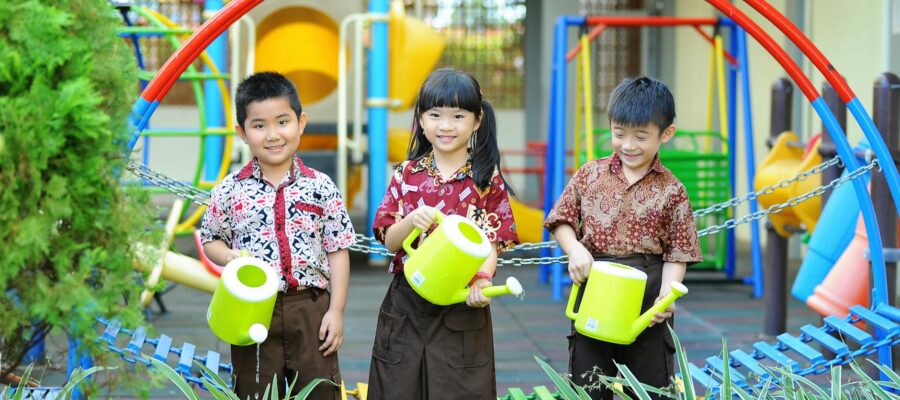Nature is magic. People have long recognized the physical and mental benefits of spending time outdoors, but as the world grows more urbanized, many find themselves increasingly sedentary and indoors, disconnected from green spaces and nature.
Although I have always loved being outdoors, living in city apartments has not given me a wealth of opportunities to hone any particular gardening skills. Yet, despite my lack of green thumb, for the past seven years, I have run an after school gardening club for students. I’m convinced that a school garden is one of the most valuable learning experiences a school can offer.
Real, Hands-On Understanding of Sustainable Development
One of the primary reasons I wanted to introduce gardening to students was to give them a real, hands-on understanding of sustainability. In fact, school gardens can directly support learning around seven of the UN’s 17 Sustainable Development Goals: no poverty, zero hunger, clean water and sanitation, decent work and economic growth, responsible consumption and production, climate action, and life on land. Through gardening, students can explore these goals in a practical, meaningful way, building a foundation for lifelong eco-conscious habits.
Gardening shifts learning from passive to active as students dig, plant, water, and harvest, experiencing firsthand the connections between humans, plants, and the planet. This tactile experience goes far beyond textbook lessons on sustainability. In our current food system, the growing population poses challenges to feeding the world sustainably. But by learning to grow food, students gain the knowledge and confidence to contribute to sustainable food practices. Cultivating their own vegetables and herbs, students develop a deeper respect for food and for the effort it takes to produce it. Watching children care for seedlings with pride—and witnessing their excitement at tasting the vegetables they grew—brings this point home in a powerful way. Many even become eager to try vegetables they previously turned their nose up at!
Building a Sense of Community
A school garden can be a powerful tool for building a sense of community. Growing a garden is no small task, and it benefits from collaboration. As the saying goes, “Many hands make light work,” and a garden brings together students, teachers, parents, and even community members. We were lucky enough to have an expert from a local nonprofit join us, sharing her knowledge on planting, soil health, and seasonal planning. After COVID restrictions lifted, parents also began volunteering, which brought consistency and support that kept the garden thriving.
But the benefits of shared gardening go beyond having extra helping hands. When different members of a community come together to create and care for a garden, bonds form naturally. Each week, responsibilities are divided up, giving each student a sense of ownership. From watering and weeding to observing insects and protecting new seedlings, every role plays a part in making the garden flourish. Perhaps the most joyful community event is harvesting the produce, made even better if you are able to assemble it into some kind of dish to enjoy together too! A garden nurtures connections, reminding everyone involved that they are part of something larger than themselves.
Cultivating Wellbeing
Beyond its environmental and community-building benefits, gardening is also an incredible boost for mental and emotional wellbeing. After a busy school day, even I found relief in the simple act of stepping into the garden. It was a chance to escape the classroom’s four walls, be in touch with nature, and shift into a slower, more mindful state.
For students, the sensory aspects of gardening—feeling the soil, smelling herbs, and listening to birds or insects—help them connect to the moment. I recommend keeping one bed specifically for digging and aerating the soil, a favorite activity that offers a calming, tactile experience and allows students to release pent-up energy. While observing plants growing and interacting with various garden creatures, a sense of peace is restored. Even with a large group of rambunctious students, I find that l leave each session feeling more centered and refreshed.
Research supports the value of green spaces for mental health. Exposure to greenery reduces stress and improves mood, cognitive functioning, and even resilience to anxiety. Whether students were eagerly harvesting vegetables or quietly observing butterflies, our school garden became a space where they could connect with the natural world and with themselves.
Ready to Start Your Own School Garden?
If you’re interested in bringing the benefits of a school garden to your students, there are many resources to guide you on your journey. Whether you’re starting with just a few pots or aiming for a full-scale garden, remember that it’s not about having a perfect plot; it’s about creating a space for growth, learning, and connection.
For inspiration and ideas to get started, check out these resources:
– **Edible Schoolyard Project:** Offers curriculum ideas, garden design tips, and sustainability resources.
– **KidsGardening.org:** Provides grants, lesson plans, and activity ideas tailored to school and community gardens.
– **National Gardening Association:** A source for gardening knowledge, with specific guides for youth and educators.
A garden is a space of possibility and growth—not only for plants but also for our students. By working together to nurture our gardens, we plant seeds of awareness, responsibility, and wellbeing in the next generation.


